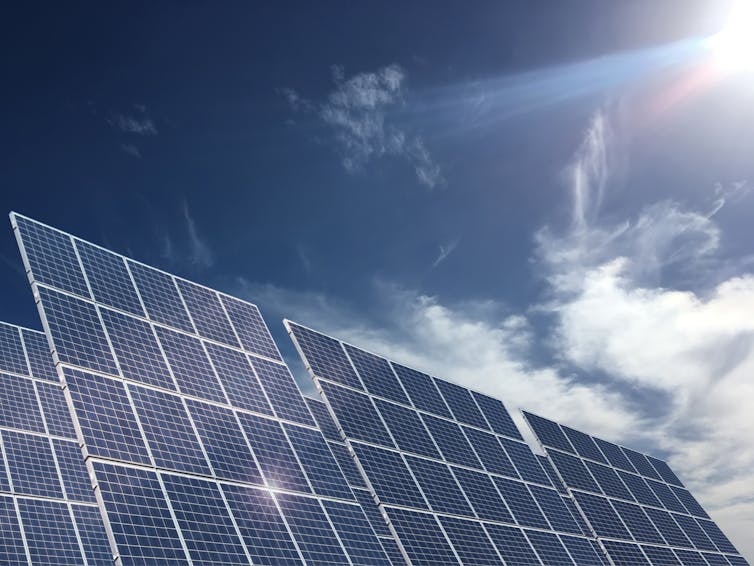Federal energy office illustrates the perils of fluctuating budgets and priorities
- The Office of Energy Efficiency and Renewable Energy (EERE) within the Department of Energy faces challenges due to fluctuating budgets and priorities, which can lead to destabilization of agencies and cut off long-term projects.
- EERE’s funding levels have varied significantly over the years, with supplemental allocations ranging from $7 billion in 2002 to $18 billion in 2022, but the future of these allocations is uncertain due to a January 2025 executive order by President Trump requesting a pause on disbursement of funds.
- The amount and direction of funding for EERE projects are influenced by shifting priorities, with Republican administrations typically supporting early-stage research and development, while Democratic administrations advocate for increased federal involvement in commercialization phases.
- Examples of successful EERE-funded projects include the advancement of electric vehicle technologies, which have seen a sharp rise in adoption, but other projects, such as hydrogen fuel cell-powered vehicles, have not done so well due to inconsistent funding and priorities.
- The current practice of ever-shifting priorities and unpredictable funding hinders long-term technological progress and discourages private investment, whereas sustained funding and institutional continuity are essential for the success of publicly funded research and development, as exemplified by peer countries that boost long-term investments in clean energy with consistent priorities and predictable funding.

When new presidential administrations enter the White House, federal agencies often find their funding and priorities shifting, sometimes dramatically.
I’m a scholar who studies how policy and market shifts affect regional economies, labor markets and public systems, particularly in the context of critical infrastructure such as energy and water. I’ve seen how both of those types of changes – of funding levels and priorities – destabilize agencies and cut off long-term projects before they achieve their intended goals.
In one research project, with co-authors Dr. Deborah A. Carroll and Zach Perkins, I took a close look at one office within a federal agency, the Department of Energy’s Office of Energy Efficiency and Renewable Energy. What we found serves as an example of how these changes have played out in the past, and it gives context to how the Trump administration’s changes are playing out now in that agency and across the federal government.
The office, known by researchers and its personnel as EERE, is mainly focused on funding research and development to advance energy efficiency and renewable energy technologies and reduce the costs of those technologies to consumers. Its key efforts involve low-emission transportation, renewable electricity generation and decreasing the carbon emissions of buildings and industry processes.
It makes grants to, and enters research and development agreements with, small businesses, industry, national laboratories, universities and state and local governments. Recipients are often required to contribute matching funds or other support to the project to complement the federal funding.
In general, Congress appropriates funding to the office as part of the yearly budget process. However, the office also receives sporadic influxes of additional funding to stimulate the economy or address concerns related to energy security and greenhouse gas emissions. Ultimately, the amount of funding EERE gets depends in part on overall economic conditions or national crises.
Boosting funding levels
Some of those supplemental allocations can be significant, and many last until the funds have been spent, even if that takes a number of years. Following the energy crisis in the early 2000s, Congress allocated EERE a total of about $7 billion in funding for research and development in energy efficiency, renewable energy and biofuels.
Then in 2009, following the Great Recession, Congress gave EERE $16.7 billion – most of which was to help low-income families pay to install efficient light sources or insulation to save them money. About $5.4 billion was for research and development.
In 2020, amid the COVID-19 pandemic, Congress passed the Energy Act of 2020, mainly focusing on nuclear energy and carbon capture technologies but also providing over $500 million in research and development funding for EERE.
In 2021, the Infrastructure Investment and Jobs Act allocated about $16.3 billion to EERE. And in 2022, the Inflation Reduction Act provided an additional $18 billion. As with other additional funding allocations, Congress made most of that money available until the total authorized amount has been spent.
But the future of these allocations is uncertain. A January 2025 executive order by President Donald Trump requested that all agencies immediately pause the disbursement of funds Congress approved in both laws.
In its 2026 budget, the Trump administration is proposing spending $900 million on EERE’s work – a 70% reduction from its 2025 allocation of $3.5 billion. This echoes a move during Trump’s first term when the White House proposed the office’s funding be cut by nearly 70% between the 2017 and 2018 budgets. However, at that time, Congress decided to keep the office’s budget largely intact. Congress will review and decide on this proposed budget as well.

alexsl/iStock / Getty Images Plus
Shifting priorities
How those varying amounts of money are spent also changes, often based on shifts in political leadership with different views about what types of technologies are most worth investing in, and about the most effective role of government in developing new technologies.
Our qualitative analysis has found that Republican administrations typically believe that very-early-stage research and development is an appropriate role for the federal government, but that as technologies move closer to commercialization, the private sector should take the lead.
In contrast, we found that Democratic administrations believe that promising innovations often fail to reach the market due to insufficient private sector support during the demonstration and deployment phases. So they tend to advocate for increased federal involvement to assist with the transition from research to market-ready technologies.
There is also a partisan difference in which technologies get financial support. Solar and wind energy technologies have historically received higher funding under Democratic administrations. In contrast, bioenergy and hydrogen technologies have received higher funding under Republican administrations.
Funding the future
EERE often funds projects that are considered too risky for private investors to fund alone. Expanding knowledge requires experimentation, so some EERE projects have achieved notable success, while others have not.
For instance, the office’s investments have played a pivotal role in both spreading electric vehicle technologies and reducing their cost to consumers. Beginning with a major funding boost from the American Recovery and Reinvestment Act of 2009, and with further allocations in subsequent years, EERE helped fund breakthroughs in battery manufacturing, power electronics and electric drive systems.
These advancements contributed to a sharp rise in adoption: In 2012, there were just 100,000 electric vehicles registered in the U.S. By 2022, that number was above 3 million. And in 2014, hybrid, plug-in hybrid and battery electric vehicles accounted for 3% of all new light-duty vehicle sales. By 2024, that share had grown to 19%.
EERE’s investments in electric vehicles powered by hydrogen fuel cells, by contrast, have not done so well. Despite significant government support in the 2000s, their commercial availability remains largely limited to California, where most of the country’s hydrogen refueling stations are located.

Cavan Images/Cavan via Getty Images
A change in approach
Our analysis of the office’s operations finds that the amount of change in funding levels and priorities can create an environment that hinders thoughtful project selection. Programs that begin under one administration can’t be counted on to continue under subsequent presidents, and dollars allocated for the future may be repurposed down the road, leaving projects only partially finished.
Studies also find that rapidly increasing budgets can create misaligned incentives as public administrators scramble to use the funds during the authorization period. For example, some may prioritize grantees who can accept and spend money rapidly, regardless of the potential public benefit of their innovation.
Further, the shifting priorities complicate long-term planning for government officials, researchers and businesses. Sustaining innovation over a long period takes years of commitment. Studies have shown that inconsistent or volatile government funding can hinder overall technological progress and discourage private investment. One example is the exploration of algae-based biofuels in the 1980s, which was shut down in the 1990s due to shifting federal priorities. That stalled progress in the field and led to a loss of more than half of the genetic legacy collected through the program. In the late 2000s, the federal government resumed funding algae-based biofuel research.
Overall, research by us and others underscores the importance of sustained funding and institutional continuity to ensure the success of publicly funded research and development. That’s what other peer countries are doing: boosting long-term investments in clean energy with consistent priorities and predictable funding.
Following that model, in contrast to the current practice of ever-shifting priorities, would create more effective opportunities to develop, produce and deploy innovative energy technologies in the U.S., helping to maintain global competitiveness and reduce reliance on foreign manufacturing.
![]()
Christelle Khalaf received funding from the Alfred P. Sloan Foundation to examine EERE R&D funding trends. She has also received funding from the Department of Energy for separate research.
